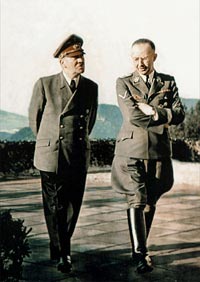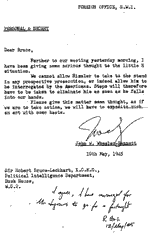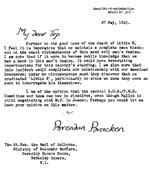
London, Saturday, July 2, 2005
[Files
on Himmler 'murder' exposed as
fake]
[SOME
OF THE FORENSIC
TESTS:
pdf] Opinion Faking our
history AS Ben Fenton
reports
today, allegations that British intelligence was
responsible for the poisoning of Heinrich
Himmler in 1945 were based on forged documents,
apparently planted in folders in the National
Archives [Public Record Office] at Kew. So
these claims which have dragged so many reputations
through the mud, are complete rubbish. Somebody,
somewhere, wanted to plant the idea that Himmler,
the head of the SS, had been suing for peace
between Britain and Germany since 1943, and that
Winston Churchill was therefore terrified of
allowing the Americans to interrogate
him. The success of the forger's ploy opens up
tremendous opportunities for us all to re-write
history. We could all award ourselves dukedoms --
or the mineral rights to Yorkshire -- simply by
slipping a fake document or two into the National
Archives. On a whim, we could file a forged
document recording the repeal of the European
Communities Act, 1972. Or we could counterfeit the
surrender of the American rebels to George
III, giving the New World to the United Kingdom
in perpetuity. This is, of course, precisely how totalitarian
states operate. In George Orwell's Nineteen
Eighty-four, Winston Smith worked in a department
dedicated to rewriting the past. It is deeply
disquieting that somebody succeeded in corrupting
files detailing such an important part of our
history.
How Himmler's
death was turned into a British murder
plot By Ben
Fenton IT is hard to imagine a more serious charge
against a government than that it would sanction
the murder of a senior member of an enemy regime,
especially when it was planning the trials of
defeated combatants. But that is the main allegation in the final
pages of Martin Allen's new book,
Himmler's Secret War.  Much of the rest contends that Heinrich Himmler,
the brutal head of the Nazi killing machine that
operated under the lightning strike symbol of the
SS, was involved from early in the war in trying to
supplant Adolf Hitler and sue for peace with
the Allies.
Much of the rest contends that Heinrich Himmler,
the brutal head of the Nazi killing machine that
operated under the lightning strike symbol of the
SS, was involved from early in the war in trying to
supplant Adolf Hitler and sue for peace with
the Allies.
The publicity for the book, not surprisingly,
concentrates on the sensational material in the
last few pages. Here, Mr Allen makes an accusation that might
have been dismissed as the sort of unsourced claim
that popular history revels in. But the charge that British intelligence -- with
the knowledge of Churchill -- had assassinated
Himmler was sourced and it was supported. Or so it seemed. Two files were produced in evidence. In one,
categorised in the National Archives as FO 800/868,
miscellaneous correspondence of the Political
Warfare Executive (PWE), are two documents.  The
(left) first purports to be a letter from John
Wheeler-Bennett of the Foreign Office who was
its liaison officer with the PWE, the shadowy group
committed to subverting the Nazis with propaganda,
subversive broadcasts and other subliminal
tactics. The
(left) first purports to be a letter from John
Wheeler-Bennett of the Foreign Office who was
its liaison officer with the PWE, the shadowy group
committed to subverting the Nazis with propaganda,
subversive broadcasts and other subliminal
tactics.
But the letter of May 10, 1945, written as the
Nuremberg trials are being prepared, is suggesting
something far more active. He tells Sir Robert Bruce Lockhart, the
head of the Political Intelligence Department of
the Foreign Office and one of the men with
operational control of PWE, that Himmler must
die. "We cannot allow Himmler to take to the stand in
any prospective prosecution, or indeed allow him to
be interrogated by the Americans. Steps will
therefore have to be taken to eliminate him as soon
as he falls into our hands." Prof M R D Foot commented that this does
not sound like the language Wheeler-Bennett, whom
he knew well, would ever use, especially not to a
superior, as Bruce Lockhart was. The need to kill Himmler, according to the Allen
thesis, arose from fears that under interrogation
he would tell the Americans that Britain had been
taking part in peace negotiations without informing
Washington. Bruce Lockhart, it is claimed, writes at the
bottom: "I agree. I have arranged for Mr Ingrams to
go for a fortnight." Mr Ingrams is Leonard Ingrams, the father
of Richard Ingrams, former editor of
Private Eye. He was a fixer for PWE and the
Special Operations Executive (SOE), but until now
never identified as a possible assassin.  The
second document in the file is a flimsy sheet,
supposedly the deciphered version of a telegram
sent by "Mr Thomas" - presumably Ingrams - to Bruce
Lockhart. The
second document in the file is a flimsy sheet,
supposedly the deciphered version of a telegram
sent by "Mr Thomas" - presumably Ingrams - to Bruce
Lockhart.
"As instructed action was taken to silence him
[Himmler] permanently … we may
conclude that the HH problem is ended." This is also supposedly noted by "R B-L" - Bruce
Lockhart's name is not hyphenated - with the
instruction to a subordinate "Copy to PM", which
neatly incriminates Winston Churchill in the
assassination.  The
last of the documents used to support the
allegation is supposed to be a letter from
Brendan Bracken, the minister of
information, thus ministerial head of PWE, and
Churchill's closest ally in the War Cabinet, to the
Earl of Selborne, titular head of SOE. It is
found in the file HS 8/944, Selborne's personal
correspondence and represents, or is supposed to
represent, the cover-up. The
last of the documents used to support the
allegation is supposed to be a letter from
Brendan Bracken, the minister of
information, thus ministerial head of PWE, and
Churchill's closest ally in the War Cabinet, to the
Earl of Selborne, titular head of SOE. It is
found in the file HS 8/944, Selborne's personal
correspondence and represents, or is supposed to
represent, the cover-up.
In this strangely modern-sounding document,
Bracken says to Selborne: "Further to the good news
of the death of Little H [Himmler], I feel
it is imperative that we maintain a complete news
blackout on the exact circumstances of this most
evil man's demise. "I am sure that if it were to become public
knowledge that we had had a hand in this man's
demise, it would have devastating repercussions for
this country's standing." Two other Bracken letters, in the same file, one
dated late 1943 and the other early 1944, both of
which have been found to be forgeries, were
involved in setting the scene for the
assassination. They lay out supposed details of the way in
which Bracken and Selborne were encouraging Himmler
to negotiate peace terms with Britain through
intermediaries. In the German case, this was Walter
Schellenberg, referred to as "WS", head of the
SD, intelligence arm of the SS, and on the British
side Sir Victor Mallet, our ambassador to
neutral Sweden. The CIA has in the past released documents
showing that they had conducted similar
negotiations with Himmler through Schellenberg and
Felix Kersten, a physiotherapist who
exercised a Rasputin-like influence on the SS
chief. But evidence of British duplicity has been less
easy to pin down. In the world of the forgeries, the British, in
particular Bracken and, by extension Churchill,
seem sinister, shifty, dishonourable and, by the
end of the show, murderous. Perhaps consideration of that might help uncover
who it was who wished to portray this view of
"history" and who has perpetrated the
forgeries.
Himmler murder files are
fakes Forgeries
exposed by a hunch and by science By Ben
Fenton AT first sight the three
documents seized on by Martin Allen to underpin
allegations that the Political Warfare Executive
was responsible for the assassination of Himmler
looked remarkable. At second sight they looked even more remarkable
because their language just did not ring true Surely, civil servants of the 1940s simply did
not use language like "eliminate him" as John
Wheeler-Bennett was supposed to, nor would even as
flamboyant a man as Brendan Bracken have spoken of
"devastating repercussions for this country's
reputation". These are the words of the late 20th century,
not its middle years. Suspicions aroused, the next step was to look
more carefully at the documents and compare them
with handwriting and signatures known to be
genuine. The Daily Telegraph was then able to
provide David Thomas, the director of
government and archive services at the National
Archives, with a sufficient prima facie case of
forgery for him to agree to a full forensic
examination. Four thick files from Kew were taken to the
Buckinghamshire laboratory of Dr Audrey
Giles, formerly of Scotland Yard's forensic
science laboratory and a scientist of unquestioned
reputation. She subjected five questionable documents to
minute examination and also looked at several
papers known to be genuine, for comparison. First, she examined three letters purporting to
come from Brendan Bracken, Churchill's confidant,
minister of information and head of the Political
Warfare Executive. One of those three, dated May 27, 1945,
apparently implicated Bracken in the cover-up of
the killing of "Little H" while the other two were
earlier letters suggesting that PWE was encouraging
Himmler to believe that he could negotiate a peace
deal with Britain. All three were claimed to have been sent to the
Earl of Selborne, the minister responsible for the
SOE, and were found by Mr Allen in the Archives
document HS 8/944. All three were supposedly typed on Ministry of
Information headed notepaper, with a salutation to
"My Dear Top" - Lord Selborne's nickname - and a
signature in Bracken's distinctive handwriting. Dr
Giles was also given six genuine original
letterheaded letters from Bracken. She examined the letterheads at x500
magnification and concluded that the relatively
ragged outline of the letters showed that "the printing of the letterhead of each
of the [suspect] Bracken letters is
composed of dry toner deposit consistent with
having been produced on a laser printer". In the genuine letters, though, the heading was
produced by a traditional embossing technique that
under the microscope produced a smooth edge. She was able to go further, and concluded that
the laser printer, not in use until the 1980s, was
a model of relatively high definition and therefore
of fairly recent manufacture. These were the findings that seemed to carry
most weight with the National Archives. Next, Dr Giles studied the salutation and
signatures on the suspect Bracken letters using a
Video Spectral Comparator which "allows the ink of
the signatures and handwritings on the documents to
be viewed in infra-red light" and she made another
damaging discovery. "My examination of the inks of the
writings on the Bracken documents clearly
revealed the presence of pencil lines under the
writings of the greeting and signature on each
of these documents." She studied the ink under a
particular infra-red wavelength."Under these conditions, the ink of the
handwriting is almost transparent but the pencil
guide lines remain dark. Indeed if the original
documents are examined carefully under a
microscope, fragments of the pencil lines are
visible." After studying genuine Bracken signatures and
handwriting that had no such lines, she reported:
"There is conclusive evidence that the Bracken
letters … are not genuine, but are simulated
documents." She also said that there was "conclusive
evidence" that the letterheads were of "relatively
recent" fabrication. Under international forensic standards, there is
no higher level of certainty than "conclusive
evidence". Dr Giles found the same level of certainty for
the view that the alleged handwriting and initials
of Sir Robert Bruce Lockhart on the letter
purported to have been sent by John Wheeler-Bennett
on May 10, 1945, [above left] was not his
handwriting. She also found "very strong evidence" - the next
highest level of certainty on the international
scale and likened to being "almost certain" of a
fact - for the proposition that the Wheeler-Bennett
letter was written on the same typewriter as the
Bracken letters, which she has conclusively found
to be forgeries. On the telegram allegedly sent by "Mr Thomas"
[above top] to Bruce Lockhart, confirming
the murder of Himmler at Luneberg, Dr Giles found
that the amount of writing was not enough for a
definite conclusion, but she came to the conclusion
that there was "strong support" for its being
forged as well. It certainly appears very similar to the forged
handwriting of Bruce Lockhart. All in all, Dr Giles has told The Daily
Telegraph that she is convinced that all the
suspect documents provided to her are
forgeries.
Himmler murder
files are fakes 'You expect everything in
PRO to be real. It's a disaster' By Ben
Fenton "Crikey," Martin Allen said when
he was told that the documents on which he based
the climax of his book were forgeries. "Bloody hell, how could that have had
happened?" The historian, who lives in Gillingham, Dorset,
denied absolutely any previous knowledge that the
papers he had discovered in the autumn of 2003 were
bogus. "It never occurred to me that anything in the
PRO wouldn't be real. You go to the PRO and expect
to find kosher documents. "It undermines the whole process of National
Archives." Mr Allen, whose other two books focused on the
flight of Hitler's deputy Rudolph Hess to
Scotland in 1941 and the alleged pro-German
activities of the Duke of Windsor, offered
to help the investigation in any way. He would also be contacting his publisher,
Robson Books, to discuss whether or not the book
should be withdrawn. "I think I will ring my publisher and
say that we have got something of a disaster
here."Something strange has happened indeed. I
really don't understand, I really don't. "It's not within my skill to do something
like this or in my interest because I'm a bona
fide historian with several books behind me. I
do my research. I spend a lot of money doing it
and I didn't expect this. I am absolutely
devastated. "You read an awful lot of documents without
finding anything at all and then when suddenly,
at the end of the day, at 4 o'clock on a wet
winter evening you find something like this. You think: 'Yippee, I've found something.
That gives me the lead on to something else'.
But if you think the archive was seeded in such
a way by the time you get the information -
that's devastating, absolutely devastating." The implications for historians in general are
profound. "Documents I find in the archives I tend to
treat as gospel," Nigel West, the intelligence
expert and historian of the SOE, said. The sort of fabrication uncovered in the Himmler
affair was unprecedented in Britain, said Prof
Richard Aldrich of the University of
Nottingham. "It has happened with the UFO lobby in America
and we have to face the fact that we are going to
have to be more sceptical where the subjects are
ones that people obsess about: UFOs, royalty, the
Kennedy assassination, or in this case the
Nazis. "The second worrying thing is that we know the
SOE had plans to bump off Hitler and there are
documents showing - although perhaps I ought to say
that appear to show - that we were planning the
same for Mussolini and his deputy. "So they are something we could almost believe
before we see them."
[Website
note: neither The Daily Telegraph nor their
journalist Ben Fenton made any attempt to
contact David Irving, Steve Kippax, or other
researchers involved in this matter before
publishing these articles].
'Revelations'
that cheered the Right SINCE Himmler's Secret
War was published, there are people who have
been gladdened by the information apparently
revealed by Martin Allen. Internet forums that discuss Nazi history have
welcomed a new subject. On the website of David Irving, the
British historian who was branded by a High Court
judge as a Holocaust
denier, there was a sense of triumph. On
June 3 on the website, which has a banner
reading The International Campaign for Real
History, Mr Irving welcomes the discovery, which he
does not attribute to Mr Allen, but to a British
researcher, Steve Kippax. Mr Irving writes: "Real historians have long
doubted the conformist version of how Himmler died,
namely that he obligingly swallowed poison when he
realised the game was up." It adds: "What is truly extraordinary is not so
much that the conformists have willingly overlooked
the inconsistencies for over 60 years but that
those involved in, or aware of, the murder - who
included Prime Minister Churchill himself - had
kept quiet about it." Further down his article, Mr
Irving says: "Brendan Bracken, Churchill's
obnoxious red-headed confidant … was also in
on the action - a war crime, despite Heinrich
Himmler's dark record, as he was a prisoner of war
who had surrendered to British custody." Commenting on Bracken's supposed remark, on one
of the forged documents, that any link between
British officials and the death of Himmler would be
very damaging to the nation's reputation, Mr
Irving, who is based in America, said: "Quite
so. "Britain's secret agents had secretly
and criminally liquidated one of the most wanted
men in history, for whose proper public trial
and punishment the blood
of millions of his victims cried out: and
for no other visible reason than to conceal that
for a few days toward the end of the war,
Churchill had negotiated with him on peace
terms." Mr Irving does not seem to question the veracity
of the documents. There is no suggestion at
this point that Mr Irving or any of his
associates or correspondents were aware of the
forgeries or had any part in them. © Copyright of
Telegraph Group Limited 2005. .
|